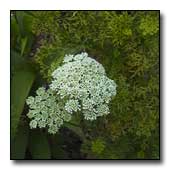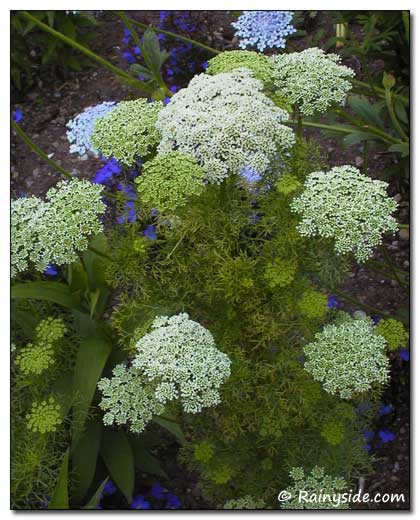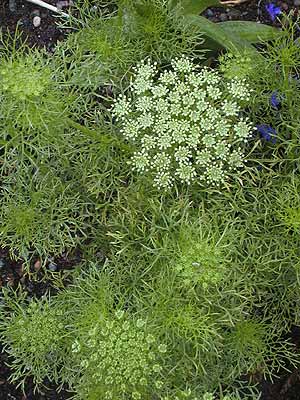Ammi visnaga 'Green Mist'
BISNAGA, FALSE QUEEN ANNE'S LACE, GREEN MIST LACE FLOWER
Family: Apiaceae
Pronounced: AM-mee vis-NA-ga

Quick Jumps
Growing Guide
Rainy Side Notes
GROWING GUIDE

Origin:
Garden.
Plant Group:
Annual or biennial.
Mature size:
Height: 2-4 feet (81 cm)
Width: 4 feet (1.21 m).
Flowering period:
Summer.
Flowering attributes:
Compound umbels bearing small, greenish-white flowers, resembling lace work.
Leaf attributes:
Stems have finely divided leaves, giving the plant a feathery, fern-like look.
Light:
Full sun to partial shade.
Soil:
Moist, well-drained, fertile soil; neutral to alkaline soil is best.
Feeding:
Add a complete organic fertilizer when planting.
Propagation Methods:
Pre-chill seed for two weeks 40-45°F (4-7°C) before sowing. Sow seed in situ in spring. To get an early start, sow seed indoors in April. Cover seed lightly. Germinate at temperatures of 68-72° F (20-22° C). Germination will normally occur within 10-14 days. Harden seedlings off and plant outdoors after last frost.
Pests and Diseases:
Susceptible to: Anthriscus, Caraway latent nepovirus, Parsley green mottle potyvirus, Parsnip leaf curl virus. I have not seen this to be a problem in my garden.
Rainy Side Notes

Like Ammi majus, A. visnaga 'Green Mist' is frequently confused with roadside Queen Anne's lace, Daucus carota, a common weed in the United States, and considered a pest in many areas.
A. visnaga adds a ferny, delicate look to bouquets, and lasting three to five days as a cut flower. Cut the flowers in the morning with 80% of the flowers opened for best results.
For dried flowers, air dry flowers for two to three weeks in a dark, dry place. Darkness is crucial to keep the white flowers from turning brown.
Be careful handling any plants in the genus, Ammi, as the sap may bring about a skin rash or irritation that can be very serious and painful. The photoactive compounds from Ammi can cause blistering to normal skin when exposed to the sun. Wash the skin area that is exposed to the sap, using soap and water. If symptoms occur after contact with plant, call your local Poison Control Center.
The fragrance of this plant is unpleasant, but not overpowering. Try these as a cut flower; you will like the look mixed in with other flowers.
Debbie Teashon
Photographed in author's garden.

Gardening for the Homebrewer: Grow and Process Plants for Making Beer, Wine, Gruit, Cider, Perry, and More
By co-authors Debbie Teashon (Rainy Side Gardeners) and Wendy Tweton
Copyright Notice | Home | Search | Annuals

